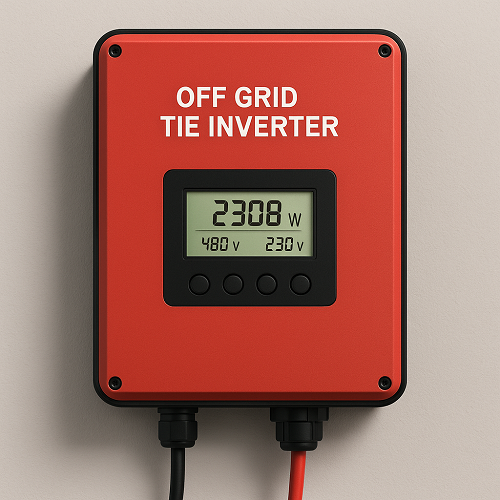The off grid tie inverter is engineered to seamlessly convert direct current (DC) power from renewable energy sources—such as solar panels or wind turbines—into alternating current (AC) suitable for both standalone use and synchronized operation with limited grid access. Designed for hybrid systems, this inverter supports energy independence in remote areas, disaster zones, agricultural settings, or any location where grid power is unstable or unavailable. It bridges the functionality of traditional off-grid inverters with the capability to connect intermittently to the grid or other energy sources when needed, making it an ideal solution for energy storage systems, rural electrification, and sustainable development projects.
Product Features
- Dual-mode Operation: Functions independently in off-grid mode and ties in with limited grid infrastructure or backup generators when available, ensuring uninterrupted power supply.
- High Conversion Efficiency: Equipped with advanced MPPT (Maximum Power Point Tracking) technology, optimizing solar energy harvesting with up to 98% conversion efficiency.
- Smart Monitoring System: Built-in LCD screen and optional remote app connectivity allow real-time tracking of system performance, fault alerts, and energy statistics.
- Robust Safety Protections: Includes over-voltage, under-voltage, over-temperature, overload, short-circuit, and anti-islanding protection, ensuring the safety of both the system and users.
- Pure Sine Wave Output: Delivers stable and clean AC output for compatibility with sensitive appliances and industrial equipment.
- Flexible Battery Support: Compatible with lithium, lead-acid, and LiFePO₄ batteries to suit different storage needs and budgets.
Product Specifications and Parameters
- Model Options: 1kW to 10kW available
- Input Voltage Range: 24VDC / 48VDC / 96VDC
- AC Output Voltage: 110V / 220V / 230V ±5%
- Frequency: 50Hz / 60Hz auto-sensing
- Waveform: Pure Sine Wave
- Efficiency: ≥ 95% (up to 98% MPPT efficiency)
- Communication Ports: RS485 / Wi-Fi / Bluetooth (optional)
- Cooling System: Intelligent fan cooling
- Protection Grade: IP20 (indoor models) / IP65 (outdoor models)
- Operating Temperature: -20°C to +60°C
Product Instructions
Installation should be performed by a certified technician to ensure system compatibility and safety. Before installation, verify battery type and voltage, confirm solar input capacity, and secure adequate ventilation. The inverter should be mounted on a non-flammable vertical surface and connected to the battery bank first before wiring the solar array. Once connected, the LCD interface provides guided configuration for mode selection, voltage limits, and battery type. Daily operation is automatic, with the system intelligently switching between solar charging, battery supply, and optional grid input. Regular maintenance involves checking terminal connections, cleaning dust from vents, and updating firmware via the app if applicable.
Product Applicable Industries
The off grid tie inverter is widely used in:
- Agriculture and Aquaculture: Powering irrigation pumps, greenhouse systems, aerators, and fishpond equipment in remote or semi-urban areas.
- Construction and Mining: Providing power for tools, lighting, and communication systems at temporary worksites.
- Telecommunications: Ensuring uninterrupted power for remote base stations and signal towers.
- Emergency and Disaster Relief: Supporting mobile medical units, shelters, and command centers during power outages or natural disasters.
- Tourism and Hospitality: Powering off-grid cabins, resorts, eco-lodges, and mobile kitchens in wilderness areas.
- Residential and Rural Electrification: Enabling households without reliable grid access to achieve energy independence.
Product Customer Groups
Our off grid tie inverter is trusted by a wide range of customers who prioritize energy resilience and sustainable power solutions. These include:
- Renewable Energy Integrators and Solar Installers seeking hybrid solutions for diverse client needs.
- Government and NGO Projects deploying infrastructure in underdeveloped or disaster-prone areas.
- Homeowners and Off-Grid Enthusiasts building self-sufficient energy systems.
- Commercial Facility Managers looking to reduce reliance on unstable grids.
- Exporters and Distributors in regions with growing demand for modular renewable energy systems.
































